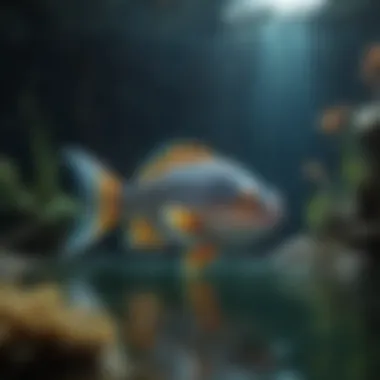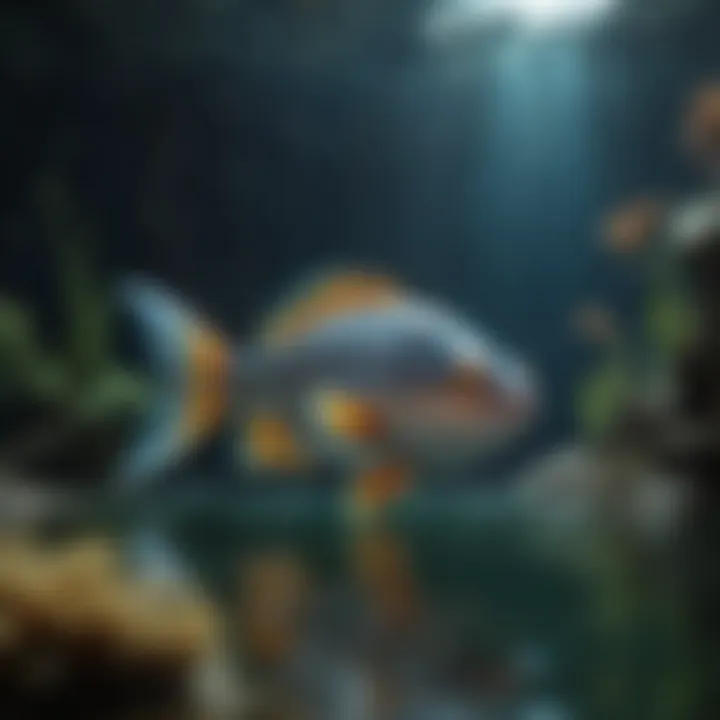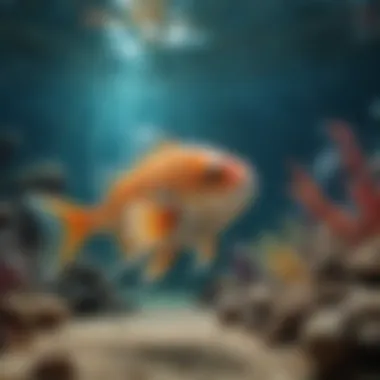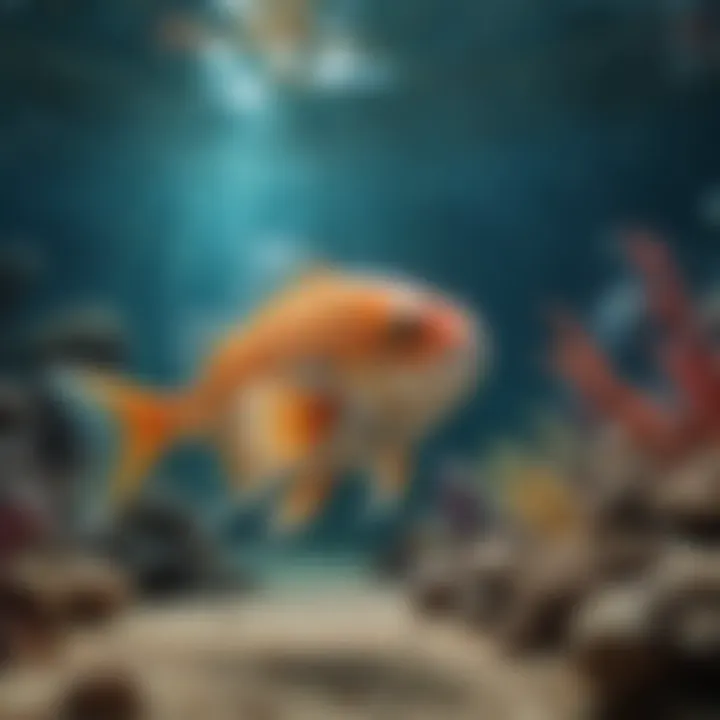Advancements in Robo Fish Technology and Its Applications


Intro
The field of robotic technology is rapidly evolving, and one niche that stands out is the development of robo fish. These robotic systems are designed to imitate the behavior and characteristics of real fish. Their design incorporates advanced technologies, enabling them to perform various tasks that benefit scientific research and environmental monitoring.
Robo fish serve multiple functions, from data collection to underwater exploration, making them vital tools in the study of aquatic ecosystems. Their ability to mimic real fish allows researchers to observe behaviors and interactions without disturbing the natural environment. This article will outline the advancements in robo fish technology and its applications, shedding light on their significant contributions to science and engineering.
Prelims to Robo Fish Technology
Robo fish technology represents a fascinating intersection of engineering, biology, and environmental science. It embodies the merging of robotics with aquatic systems to create devices that mimic fish behavior. This technology is not merely an academic pursuit; it holds practical significance across various fields. Understanding its foundations allows for better utilization in environmental monitoring, scientific research, and aquaculture practices.
Definition and Concept
Robo fish can be defined as robotic systems designed to imitate the movements and behaviors of real fish. These devices range from simple models to complex machines equipped with advanced sensors. The basic concept revolves around creating autonomous underwater vehicles that can navigate environments similar to natural fish.
The core functionality typically includes propulsion mechanisms for movement through water, mimicking the way fish swim. This requires careful design addressing hydrodynamics, stability, and maneuverability. With advancements in technology, robo fish are becoming more sophisticated, capable of integrating various forms of sensor technology to gather data from aquatic environments.
Historical Context
The journey of robo fish technology began in the late 20th century when researchers started exploring robotic systems for underwater exploration. Early prototypes were often rudimentary and focused on basic motion without much emphasis on bio-mimicry. The advancement of engineering materials and the desire to learn from biology sparked significant progress in this area.
Over time, projects such as the development of the AquaRobot project highlighted potential applications for environmental monitoring. Universities and research institutions began developing more advanced robotic fish capable of performing tasks like surveying marine ecosystems and detecting pollutants. The last decade has seen a more concerted effort from both academic and industry players, leading to more refined technologies with real-world applications.
Significance of Bio-Inspired Designs
Bio-inspired designs are crucial for the development of effective robo fish. Nature provides blueprints that have evolved over millions of years. By studying these natural systems, engineers can create more efficient and functional robotic counterparts.
This design philosophy leads to several advantages:
- Efficiency in Movement: Mimicking fish reduces energy consumption in propulsion.
- Ecosystem Compatibility: Robo fish designed to resemble their biological counterparts can blend into natural environments, minimizing disturbance to marine life.
- Enhanced Functionality: By incorporating strategies observed in fish for navigation and foraging, robo fish can perform complex tasks more effectively.
Bio-inspired designs harness the power of evolution, helping create solutions that are more aligned with natural systems.
In summary, the introduction to robo fish technology encompasses foundational insights into its definition, historical developments, and bio-inspired designs. These aspects set the stage for understanding the modern applications and implications of this fascinating technology.
The Mechanics of Robo Fish
Understanding the mechanics behind robo fish technology is crucial in recognizing the complex interplay of design and functionality. This section elaborates on how different engineering aspects contribute to the efficiency and effectiveness of these bio-inspired devices. By examining the underlying mechanical features, we can appreciate the innovative approaches that enhance the applicability of robo fish in various fields.
Design Features
Materials Used
The materials selection is vital in constructing robo fish. Often, lightweight and durable materials such as plastics and composites are utilized. These materials ensure that the robo fish can withstand underwater conditions while remaining buoyant. A key characteristic of these materials is their resistance to corrosion, which is crucial in aquatic environments. The use of high-strength polymers provides flexibility along with robustness, allowing for intricate designs that can simulate real fish behavior.
However, the performance of certain materials can vary with temperature and pressure changes, which is a consideration when deploying these devices in different aquatic settings.
Size and Dimensions
Size plays an important role in the functionality and realism of robo fish. Smaller models often mimic young or smaller fish species, while larger models can imitate adult fish. This variation in size helps cater to different applications, such as research on fish behavior or environmental studies. The main advantage of scaled-down designs is their reduced drag, allowing for more agile movement through the water. Conversely, larger designs can carry more sensors and functionalities. Thus, understanding the optimal size for the intended purpose is essential in the design phase.
Surface Structure
The surface structure of robo fish significantly affects their hydrodynamic properties. Engineers aim for a smooth texture that mimics the skin of natural fish. This feature reduces water resistance, facilitating smoother navigation through aquatic environments. Additionally, using surface coatings that reduce biofouling— the accumulation of microorganisms, algae, and small animals— extends the operational lifetime of these devices. A poor choice in surface structure can lead to increased drag, which compromises the efficiency and operating range of the robo fish.


Movement and Propulsion
Movement and propulsion systems are fundamental components that dictate how robo fish operate in water. They determine not only the speed but also the maneuverability of these devices, making the choice of propulsion methods critical.
Actuation Methods
There are various actuation methods for robo fish, including mechanical and pneumatic systems. Mechanical drives commonly utilize motors and servos, which provide precision in movement. These actuation systems allow for coordinated and lifelike swimming motions. A significant advantage of mechanical systems is their adaptability; however, they may require continuous maintenance. Pneumatic systems can offer smoother movements but can be challenging to integrate due to complexity.
Control Systems
Control systems govern the behavior of robo fish, ensuring they respond accurately to programmed commands or environmental stimuli. The integration of advanced algorithms enhances real-time decision-making capabilities. For instance, PID controllers are often employed to adjust movements based on feedback from sensors, achieving balance and stability while swimming. This adaptability is beneficial for research purposes, as it allows robo fish to navigate in varied aquatic conditions. Still, the reliance on sophisticated electronics presents a challenge in terms of durability and reliability under similar conditions.
Energy Sources
Selecting an appropriate energy source is another significant aspect of robo fish mechanics. Many units are powered by rechargeable batteries, ensuring they are capable of long deployment periods. Other options include solar panels, which can extend operation times without needing frequent recharging.
The main characteristic of these energy sources is their availability and efficiency. Depending on the intended use of the robo fish, the energy system must not only provide sufficient power but also fit within the design's constraints. A disadvantage is that energy efficiency can be hampered in cold or turbulent waters, requiring innovations in energy management to optimize performance.
"The design and mechanics of robo fish highlight the intricate connection between biology and engineering, paving the way for advancements in robotics and ecology."
With a deeper understanding of these mechanical principles, we can appreciate the sophisticated engineering that underpins the operations of robo fish, making them a potent tool in various research and ecological applications.
Sensor Technology in Robo Fish
Sensor technology is crucial for the functionality and effectiveness of robo fish. These devices mimic the sensory capabilities of real fish, allowing them to interact with their surroundings. Understanding how sensors operate within robo fish can help in various applications, including environmental monitoring and scientific research. The integration of sensor technology is what turns a simple robotic device into a sophisticated tool for data collection and analysis in aquatic environments.
Types of Sensors
Water Quality Sensors
Water quality sensors are vital to maintaining the health and safety of aquatic ecosystems. These sensors monitor parameters like pH, dissolved oxygen, and turbidity. A key characteristic of water quality sensors is their ability to provide real-time data. This is beneficial because it allows for immediate responses to changes in the environment. The unique feature of water quality sensors is their precision; they can detect small changes in water chemistry that could indicate pollution or other ecological issues. However, they may require regular calibration, which can be a disadvantage in remote or hard-to-reach locations.
Environmental Sensors
Environmental sensors play an important role in gathering data about the physical and chemical properties of water and the surrounding area. They can measure temperature, salinity, and even light levels. The key characteristic of environmental sensors is their versatility. This makes them a popular choice for comprehensive environmental studies. A unique feature of these sensors is their capability to work in combination with other technologies, such as GPS. While they offer valuable data, a disadvantage may be the complexity of data interpretation, requiring careful analysis to draw meaningful conclusions.
Navigation Sensors
Navigation sensors are essential for the movement and positioning of robo fish in aquatic environments. They help in determining location, direction, and altitude, ensuring precise navigation. The key characteristic of navigation sensors is their ability to provide accurate positioning information, which is crucial for tasks such as mapping and exploration. A unique feature of these sensors is their integration with advanced algorithms that improve navigation precision. However, they may face challenges in complex underwater terrains, where traditional navigation methods can be ineffective.
Data Collection and Processing
The data collection and processing capabilities of sensors in robo fish are pivotal for successful implementation in scientific research and monitoring. These systems can compile vast amounts of data from various sensors, analyze it in real-time, and produce actionable insights. Effective data processing ensures that the information collected is reliable and useful. With advancements in artificial intelligence, the efficiency and accuracy of these data processing methods are continually improving, paving the way for more sophisticated applications in both commercial and research settings.
Robo Fish in Environmental Monitoring
The integration of robo fish in environmental monitoring is a profound advancement in understanding aquatic ecosystems. These robotic entities mimic the movements and behaviors of real fish, enabling researchers to gather data without significantly disturbing marine life. By deploying robo fish in various aquatic environments, scientists can obtain accurate readings on water quality, biodiversity, and habitat conditions.
Marine Ecosystem Studies
Robo fish play a critical role in marine ecosystem studies. Their ability to navigate through complex underwater habitats allows for detailed observations that are difficult to achieve using traditional research methods. Robo fish are equipped with sensors that measure various parameters, such as temperature, salinity, and pH levels.
With the capability to move silently, these robotic fish can monitor areas that would otherwise be affected by the presence of human divers or research vessels. This non-invasive approach enhances biodiversity assessments, as it provides insights into species distribution and behavior. Furthermore, the data collected can be used to assess the health of marine ecosystems over time, helping to identify changes that may be linked to climate change or human activity.


Effectiveness in Pollution Detection
The effectiveness of robo fish in pollution detection is a significant advantage in environmental monitoring. Equipped with advanced sensors, these robots can identify pollutants such as heavy metals and harmful chemicals in water bodies. They can swim through various depths and locations, making them suitable for real-time monitoring in areas that are difficult to access.
Their deployment can also enhance pollution response strategies. For example, if a pollution event occurs, robo fish can quickly provide data on the spread and concentration of contaminants, facilitating timely intervention. The ability to gather precise data in real-time not only helps in managing water quality but also in making informed decisions regarding conservation efforts.
The use of robo fish in pollution detection represents a cutting-edge approach that enhances both data accuracy and efficiency in environmental monitoring.
In summary, the use of robo fish in environmental monitoring offers unique advantages, providing valuable insights into marine ecosystems and pollution dynamics. The continuous advancements in their design and functionality promise even greater contributions to underwater research and conservation efforts.
Applications in Scientific Research
The examination of robo fish technology plays a crucial role in contemporary scientific research. These innovative systems can replicate certain aspects of live fish behavior, providing essential tools for researchers to study various aquatic phenomena. The integration of bio-inspired robotics into experimental frameworks enables detailed insights into fish behavior, ecology, and interactions with their environment.
Fish Behavior Studies
Robo fish are becoming increasingly important in the study of fish behavior. One central advantage of using robotic fish is the ability to control and manipulate their interactions without disturbing the natural population. For instance, scientists can program these devices to mimic the movements and characteristics of real fish in natural settings. This allows for the observation of genuine behavioral responses from living fish in a less intrusive manner.
In addition to minimizing disruption, robo fish can be equipped with advanced sensor technology that monitors fish behavior continuously. Researchers can analyze data on attraction, aggression, and schooling behavior under various environmental conditions. These studies not only contribute to the understanding of social structures within fish populations but also inform conservation efforts by identifying critical habitat needs.
Underwater Robotics Development
Robotic fish also play a significant role in the development of underwater robotics more generally. As technology advances, these robotics systems undergo extensive experimentation, improving design and performance. Many aspects of underwater vehicle design draw inspiration from the streamlined movements of fish, which leads to increased efficiency in underwater navigation.
The iterative design processes used in creating robo fish often result in innovations that enhance propulsion systems, energy efficiency, and maneuverability. For example, understanding how different shapes impact swimming speed can guide developers in creating more efficient underwater vehicles for research and monitoring.
Furthermore, the data collected from the operation of these robots can help identify their limitations and guide future enhancements. This blend of bio-inspired design and practical application exemplifies the significant breakthroughs in robotics that stem from studying natural behaviors.
"Robo fish serve not only as fascinating research tools but also as catalysts for advancements in underwater robotics and environmental studies."
Through both fish behavior studies and the broader development of underwater robotics, the application of robo fish technology is proving integral to ongoing research efforts. The insights gained from these applications will continue to shape our understanding of aquatic environments and inspire future technological advancements.
Robo Fish in Aquaculture
Robo fish technology is poised to profoundly influence aquaculture, the sector related to raising fish commercially in controlled environments. This section explores how robotic technologies, particularly those resembling real fish, can enhance farming practices and promote sustainability.
Impact on Farming Practices
The integration of robo fish in aquaculture has brought forward significant advancements that can improve productivity and efficiency in fish farming. Robotic fish can be utilized in various ways, such as monitoring fish health, behavior, and the overall pond environment.
- Behavioral Analysis: Robo fish can be employed to observe and analyze the behavior of live fish. By mimicking the movement and appearance of natural schools of fish, these robots can reduce stress in farmed fish. This behavioral monitoring can lead to better growth rates and healthier stock.
- Data Collection: Equipped with sensors, robo fish can gather data on water quality parameters like temperature, pH levels, and dissolved oxygen. This real-time data collection enables farmers to make informed decisions, ensuring optimal conditions for fish growth.
- Feeding Efficiency: Robo fish can also aid in improving feeding strategies. They can simulate feeding times and patterns, attracting fish to specific areas, thus optimizing feed usage. This is crucial as overfeeding can lead to heightened costs and environmental degradation.
Sustainability Aspects
Sustainability is at the forefront of discussions around aquaculture. Robo fish technology presents several avenues to support sustainable practices in fish farming.
- Reduced Chemical Use: Monitoring with robotic fish can minimize the reliance on chemical treatments for diseases or parasites. Early detection through continuous observation helps in taking timely actions, therefore reducing the overall chemical input needed in aquaculture operations.
- Resource Management: The use of robo fish can contribute to better resource management by optimizing water use and feed resources. By ensuring that fish receive the precise amount of resources they need, farms can greatly reduce waste and conserve natural resources.
- Lower Environmental Impact: Robo fish can help minimize the environmental footprint of aquaculture by reducing overfishing in wild populations. They can also limit the need for wild fish in feed, which is essential for the sustainability of ocean ecosystems.
"Robotic technologies in aquaculture hold the potential to redefine how we approach fish farming, focusing on efficiency and ecological balance."
Challenges and Limitations
Understanding the challenges and limitations of robo fish technology is crucial for recognizing its full potential and addressing its current shortcomings. The development and widespread implementation of these bio-inspired robotic systems face various obstructions that necessitate thorough review and consideration. Technical challenges and ethical implications come to the forefront, influencing the effectiveness, reliability, and acceptance of robo fish in various applications.


Technical Challenges
Durability
Durability refers to the ability of robo fish to withstand harsh underwater environments while maintaining functionality. This aspect is essential because harsh conditions can include debris, fluctuating temperatures, and salinity levels. A strong emphasis on durability ensures that robo fish can perform effectively over extended periods.
One key characteristic of durable designs is the choice of materials. For instance, using high-grade plastics or metals can greatly enhance the integrity of the robo fish. Such materials resist corrosion from saltwater and damage from impacts, making them a popular choice in the design process.
However, the unique feature of durability in robo fish poses challenges as well. While robust materials may increase longevity, they can also raise costs. The addition of heavy-duty components may lead to higher manufacturing expenses and affect the overall energy consumption of the devices. Thus, balancing durability with cost and energy efficiency remains a critical focus.
Cost-Benefit Analysis
The cost-benefit analysis is an integral part of developing and deploying robo fish technology. This aspect evaluates if the financial investment in these robotic systems justifies the benefits they provide. Assessing the long-term advantages, such as enhanced research capabilities and environmental monitoring, against the initial and ongoing costs is essential for stakeholders.
One significant characteristic of a comprehensive cost-benefit analysis is the need to forecast potential savings from pollution detection and ecosystem monitoring. These savings can accrue from improved data collection methods leading to better resource management. However, the unique feature of this analysis also reveals challenges. Initial costs for designing and producing advanced robo fish can be substantial. Thus, organizations may hesitate to invest without a clear understanding of the return on investment.
Ethical Considerations
Ethical considerations play a pivotal role in the deployment of robo fish. These issues encompass both environmental and societal dimensions. On one hand, there is a question of potential harm to natural ecosystems. Critics argue that introducing robotic entities may disrupt local wildlife or alter natural behaviors in ways that are not yet understood.
On the other hand, the promotion of more sustainable and efficient practices in fishing and aquaculture presents ethical arguments in favor of robo fish. By potentially reducing the harm done to fish populations and better monitoring environmental health, the technology can aid in preserving aquatic ecosystems.
"As we advance in technology, we must remain vigilant about its impact on nature and society."
Ultimately, it is necessary for industry leaders and researchers to carefully weigh these ethical considerations alongside the technological advancements. Engaging in transparent dialogues with stakeholders can foster informed decision-making, ensuring the responsible use of robo fish in various applications.
Future Prospects for Robo Fish Technology
The future prospects for robo fish technology are promising and multi-dimensional. This aspect is crucial because it outlines the direction in which this field is heading. Current advancements indicate that these bio-inspired robots can significantly enhance aquatic research and environmental monitoring. Investment in this area may lead to breakthroughs that could address various ecological and engineering challenges.
Innovations in Design
Innovative design is at the forefront of developing robo fish. Recent advancements focus on improving mobility, efficiency, and lifelike appearance. Designers are working on the integration of soft robotics, which allows for greater flexibility and the ability to navigate complex underwater environments. Advanced materials such as silicone and eco-friendly polymers are being used to create more realistic fish movements.
Furthermore, incorporating intelligent systems like artificial intelligence can enhance the adaptability of these robots. Machine learning algorithms can be employed to teach the robo fish to adapt to different ecological conditions and behaviors. This innovation not only makes them more useful for research but also highlights their potential in education and public engagement.
Expanding Applications
As the capabilities of robo fish continue to grow, so does their range of applications. Initially used for environmental monitoring, the scope is now expanding to other domains. In scientific research, they can be used to conduct behavioral studies of marine life, providing insights that may be difficult to achieve through traditional methods.
Other applications include:
- Search and Rescue Missions: Their ability to navigate underwater could aid in locating objects or wildlife in distress.
- Aquaculture Monitoring: Robo fish can facilitate real-time data collection concerning farm ecosystems and fish health.
- Pollution Detection: The integration of sensors enables real-time monitoring of water quality, proving beneficial in evaluating the impact of human activities on aquatic environments.
The potential for evolving robo fish platforms into multifunctional tools is vast. As new technologies emerge, it is likely that these robotic systems will play an increasingly integral role in both scientific and commercial applications.
Closure
Robo fish technology represents a significant frontier in both robotics and environmental science. The conclusion of this article serves as a moment to reflect on the implications of the discussions surrounding robo fish. By summarizing the main points that have been covered, it becomes clear that these bio-inspired designs not only mimic the movements and behaviors of aquatic life but also offer innovative solutions to various challenges in underwater research, environmental monitoring, and aquaculture.
Recapitulation of Key Points
- Definition and Significance: Robo fish are essentially robotic devices designed to mimic real fish, contributing to advancements in multiple areas, including environmental research and technological innovation.
- Mechanical Components: The design of robo fish employs specialized materials, actuation methods, and various sensors that enhance functionality in real-world applications.
- Environmental Monitoring: These robotic fish play a crucial role in studying marine ecosystems, detecting pollution, and enabling scientists to gather data without disturbing natural habitats.
- Scientific Research: They are instrumental in understanding fish behavior and contributing to the development of underwater robotics.
- Applications in Aquaculture: Robo fish technology influences modern farming practices, addressing sustainability and efficiency in aquaculture.
- Challenges: The field faces several challenges such as durability, cost, and ethical considerations regarding the application of such technology.
- Future Prospects: Innovations continue to emerge, promising expanded applications across disciplines tied to water environments.
Final Thoughts on Robo Fish Technology
Robo fish offer much more than just a technological novelty; they represent a proactive approach to addressing significant environmental and scientific challenges. As technology continues to evolve, the potential of robo fish will likely expand, opening doors to new applications and enhanced functionalities.
Investing in the development and deployment of these technologies will promote better understanding of aquatic environments, significantly influencing conservation efforts and the future of underwater robotics. The nascent field promises to blend ecological awareness with advanced engineering, showing that such interdisciplinary approaches can lead to substantial progress.
By embracing robo fish technology, students, researchers, educators, and professionals can gain valuable insights that will guide future innovations in an increasingly complex world.







